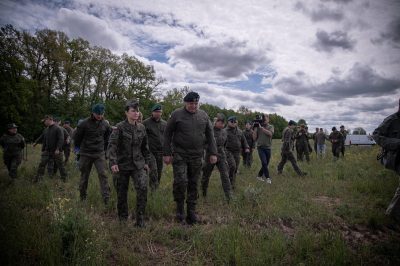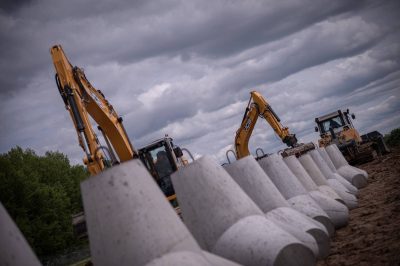“Kaliningrad border guards have observed active military infrastructure development along the border on the Polish side. At the same time, Polish authorities are evicting local residents from border areas,” reports the NIA-Kaliningrad site, mixing misinformation with factual observations.
On 23 May 2025, Polish military officials invited journalists to the Polish-Russian border, showcasing the ongoing construction of an engineering barrier. Russian propagandists seized upon this event, portraying the barrier’s construction as an unexpected development, despite its widely known status within Poland. As is typical, they lied.
The barrier in question forms part of “Tarcza Wschód” (Eastern Shield), a national deterrence and defence programme launched by Ministry of National Defence and General Staff of the Polish Army. It entails the constructing of fortifications, terrain obstacles, and military infrastructure along Poland’s borders with Russia and Belarus, spanning approximately 800 kilometres. The programme also envisages investments in reconnaissance and threat detection systems, forward operating bases, logistics hubs, warehouses, and anti-drone systems.
The national deterrence and defence programme “Eastern Shield” is a Polish initiative to be implemented in 2024–2028, designed to enhance Poland’s resilience against potential attacks and hybrid warfare scenarios. It has been developed in response to Russia’s aggression against Ukraine and shaped by the lessons of that war but it is a peaceful undertaking and its primary objectives are to deter potential aggressors, protect soldiers and civilians, and to demonstrate Poland’s readiness, alongside its allies, to defend its borders.
“The purpose of the Eastern Shield is to dis
courage any potential aggressor. It’s there to ensure that no one even considers attacking Poland, attacking the eastern flank of NATO. That’s the reason we are building it. And we will be speeding up the process. (…) Our priority is preparedness with equipment, fortifications, and drone and anti-drone capabilities – which will be an essential part of Tarcza Wschód,” explained Deputy Prime Minister and Defence Minister Władysław Kosiniak-Kamysz during an address to troops in autumn 2024.
“Although the engineering barrier is the most visible element, the Eastern Shield also envisages systems for reconnaissance, warning, chemical defense, logistics, force protection, mobility and counter-mobility, and the adaptation of medical infrastructure to the needs of the Polish armed forces in the region, ” wrote Polish military officials on Facebook.

As previously mentioned, on March 23rd, at a press conference held near the Russian border, Polish military personnel demonstrated the progress of construction on the barrier. “Given the significant deterioration of the security environment in our region, and anticipating potential developments, we initiated defensive preparations well in advance. This is why the national ‘Shield East’ programme is being implemented,” explained Lieutenant General Stanisław Czosnek, Deputy Chief of the General Staff of the Polish Armed Forces, to reporters. He added, “Here, we are showcasing a living organism, which is another construction site for elements of Shield East. Everything you see up close is the result of our conceptual work, but above all, the lessons learned from the war in Ukraine.”
During the conference, discussions extended beyond military matters. It was also announced that there are no plans to expropriate residents of their properties. “The military utilises state treasury lands, military installations, and the property of local governments. There are no expected instances of private property being infringed upon,” assured the military official.
On 26 May, General Czosnek reaffirmed that the m

ilitary, in its search for land to construct the Eastern Shield, is utilising land owned by the military, the state, and local governments.
Some residents had previously feared that the military might expropriate their land or hinder, or even prevent, them from conducting business. However, these concerns have proven unfounded. “In the year that the Eastern Shield has been in operation, there has not been a single instance of private property belonging to people living in the region being violated in any way,” Lieutenant General Stanisław Czosnek emphasised in an interview with PAP.
Several days later, sensationalist reports about the construction of the barrier surfaced in the Russian media. These reports were based on information provided to the RIA-Novosti news agency by a former Polish judge who had fled to Belarus in 2024, where he obtained political asylum. Poland is seeking his extradition on charges of espionage.
Poland has begun constructing military infrastructure near the border with the Kaliningrad region. Authorities are already evicting people and sending soldiers to dig trenches. This was reported by former Polish judge Tomasz Szmydt,” as quoted by Komsomolskaya Pravda (https://www.kp.ru/online/news/6401475/).
“The Polish authorities are swiftly depriving Poles in the border zone of their property rights. Information on the movement of people is not disclosed, and the Polish press is also prohibited from presenting this information,” Tomasz Szmydt lies.
“Kaliningrad border guards have observed active construction of military infrastructure along the border on the Polish side. At the same time, Polish authorities are evicting local residents from border areas,” reports the NIA-Kaliningrad site, mixing misinformation with factual observations. (https://39rus.org/news/policy/72556).
To reiterate: in the year since the Eastern Shield project began, there has not been a single instance of private property being violated in any way for residents living in the area. Nor has anyone been evicted.
By Igor Hrywna
Eastern Shield: National Deterrence and Defence Programme
Królewiec, Not Kaliningrad
The Królewiec Oblast (Russian: Kaliningrad Oblast) was established after the former East Prussia was divided between the Soviet Union and Poland in 1945.
The German name of the city (and the surrounding region) was changed on 4 July 1946, when Königsberg was renamed Kaliningrad, and the Königsberg Oblast, established a few months earlier, became the Kaliningrad Oblast.
This renaming was in honour of Mikhail Kalinin (1875–1946), a Soviet criminal, who as chairman of the Presidium of the Supreme Soviet of the USSR, held a position equivalent to that of a president. However, his legacy is stained by his involvement in mass communist crimes. Most notably his signature appears on the order to execute Polish officers in 1940, an act perpetrated by the Soviet NKVD secret police, resulting in the deaths of approximately 22,000 citizens of the Second Polish Republic. The victims included 14,500 prisoners of war—officers and police personnel detained in the Kozelsk, Starobilsk, and Ostashkov camps—along with 7,300 prisoners arrested within Soviet-occupied territories.
German population who remained in the area in 1945 was expelled and replaced by settlers from Russia, Ukraine, and Belarus. Throughout the Soviet era, the oblast was maintained as a restricted zone, primarily due to its extensive militarisation and the establishment of a naval base in Baltiysk for the Russian Baltic Fleet.
Post-1991, the oblast has functioned as a heavily militarised Russian enclave, geographically isolated and bordered by Poland and Lithuania.
The Polish name Królewiec has a long-standing historical tradition, dating back to the 14th century and remaining in use until 1946, when the city was absorbed into the USSR and renamed Kaliningrad.
The name Kaliningrad was an imposed name in Poland, but the decision to revert to the old name was only made after Russia’s attack on Ukraine in 2023. In making this change, the Commission on Standardisation of Geographical Names Outside the Republic of Poland took into account, among other things, the following factors:
- ”The city, currently bearing the Russian name Kaliningrad, is known in Poland under the traditional name Królewiec.”
- “Events related to Russia’s aggression against Ukraine, the imposition of the so-called Russian world (russkiy mir), and Russia’s conduct of information warfare necessitate a different view on imposed names—names that provoke strong controversy and are not accepted in Poland.”
- “Every country has the right to use traditional names in its own language that are part of its cultural heritage and cannot be forced to use names that it does not accept.”

COMMENTS